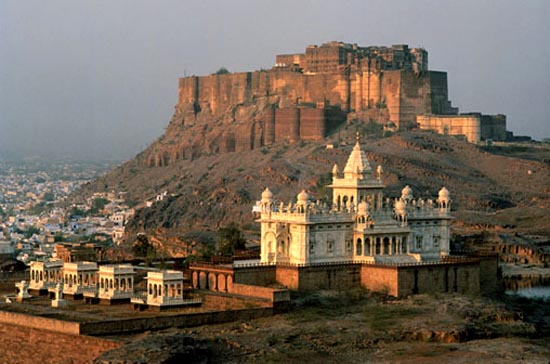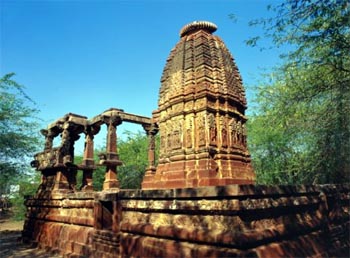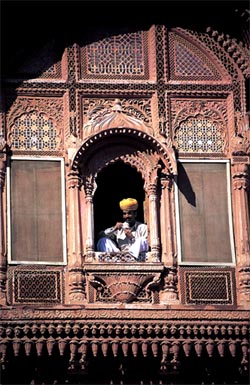Apr 15, 2025
Apr 15, 2025
Jodhpur – a stone-sculpted city rising out of the golden sands of Rajasthan. Here the blazing sun creates illusions of shimmering lakes on the arid expanse. Sand-dunes stand in eerie silence and sandstorms rage occasionally.

Jodhpur, once the capital of the former princely state of Marwar, is now the second largest city of Rajasthan. The city, standing on the eastern fringe of the Thar Desert has the distinction of neither being in the Thar Desert nor out of it. At best, it is a doorway to the wonderland of sand-dunes and shrubs, rocky terrains and thorny trees. The home of the Rathore – the awesome princely state of Rajasthan.
 In 1459 AD, Rao Jodha, chief of the Rathore clan of Rajputs, claimed to be the descendent of Rama, the epic hero of the Ramayana, and it was he who laid the foundation of Jodhpur. A high stone wall protects the well-fortified city. The wall is nearly 10km in length and has eight gates facing various directions. Within, stands an imposing fort on a low range of sandstone hills, about 125 km above the surrounding plains. Invincible! And dauntless in its league with time! The city lies at the foot of the hills. The clear distinction between the old and new city is visible from the ramparts of the fort.
In 1459 AD, Rao Jodha, chief of the Rathore clan of Rajputs, claimed to be the descendent of Rama, the epic hero of the Ramayana, and it was he who laid the foundation of Jodhpur. A high stone wall protects the well-fortified city. The wall is nearly 10km in length and has eight gates facing various directions. Within, stands an imposing fort on a low range of sandstone hills, about 125 km above the surrounding plains. Invincible! And dauntless in its league with time! The city lies at the foot of the hills. The clear distinction between the old and new city is visible from the ramparts of the fort.
On the other side of the city, facing the fort is the Umaid Bhawan Palace, one of the most spacious, sprawling and well-planned palaces in India. And from here, as you look at the fort, a tantalizing view rises before your eyes at sunset. The peculiar slant of the sunlight lends the desert landscape an awe-inspiring glow and the people, a chivalry undaunted.
 Guarding the city below, crowning a perpendicular cliff, the Mehrangarh Fort was founded by Rao Jodha in 1459 AD when he shifted his capital from Mandore. The fort standing sentinel to the city below overlooks the rugged and rocky terrain and houses a palace intricately adorned with long carved panels and latticed windows exquisitely wrought from red sandstone. The apartments within, have their own magic – the Moti Mahal (Pearl Palace), Phool Mahal (Flower Palace), Sheesh Mahal (Mirror Palace), Sileh Khana and Daulat Khana with a rich varied collection of palanquins, howdahs, royal cradles, miniature paintings of various schools, folk music instruments, costumes, furniture and am impressive armory. The display of cannons on the ramparts near Chamunda temple is among the rarest in India. On important occasions, folk musicians and bands augur a whiff of nostalgia.
Guarding the city below, crowning a perpendicular cliff, the Mehrangarh Fort was founded by Rao Jodha in 1459 AD when he shifted his capital from Mandore. The fort standing sentinel to the city below overlooks the rugged and rocky terrain and houses a palace intricately adorned with long carved panels and latticed windows exquisitely wrought from red sandstone. The apartments within, have their own magic – the Moti Mahal (Pearl Palace), Phool Mahal (Flower Palace), Sheesh Mahal (Mirror Palace), Sileh Khana and Daulat Khana with a rich varied collection of palanquins, howdahs, royal cradles, miniature paintings of various schools, folk music instruments, costumes, furniture and am impressive armory. The display of cannons on the ramparts near Chamunda temple is among the rarest in India. On important occasions, folk musicians and bands augur a whiff of nostalgia.
The Umaid Bhawan Palace, with its sculpted lawns and sandstone of bougainvillea bushes, are a soothing sight in the midst of this desert city. Built by Maharaja Umaid Singh, and named after him, this exquisite palace is also known as Chittar Palace because of a particular type of Sandstone used.
Another place on the sight-seeing list is Mandore, the former capital of Marwar, north of Jodhpur. Worth seeing are the old cenotaphs and caves in the crags, which once sheltered ascetics. The exquisitely landscaped gardens come alive with peacocks and monkeys and the sprawling greenery of sacred peepal, banyan, bottle-brush, pomegranate, palms and plantains and bubbling fountains are a feast for the eyes. Set against a rocky backdrop are “Hall of Heroes”, and “Shrine” of the 330 million gods.
Old Haat bazaar culture is still alive at the well planned Sardar Market near the Clock Tower. Throbbing with activity, the colorful bazaar with tiny shops sells exquisite Rajasthani textiles, handicrafts, clay figurines of camels and elephants, marble curios with inlay work and exquisite Rajasthani silver jewellery.
The Mahamandir temple is another tourist haunt. It is a place where scared glory reigns in a peaceful tranquility situated on Mandore Road, the temple is an architectural splendor, supported by 84 pillars and ornamented with detailed designs and figures depicting various postures of yoga. The overall structure is marked by a unique and original style.
Then there is the Kailana Lake on Jaisalmer road. This is a charming picnic spot with a small artificial lake. It is like a canvas with a splash of romantic colors. Balsamund Lake too happens to be an enchanting picnic spot with cool breezes weaving through the lush groves of mango, guava, papaya and other fruits. It is a placid artificial lake with a summer palace on the embankment. It was built by Balak Rao Parihar in 1159 AD. The serene surroundings will leave you at peace with yourself.
History and Geography revel in the dunes of Jodhpur, the land of beauty and reverence that Rajasthan stands for.
The evocative landscape finds an echo s we go further north-west to picturesque Jaisalmer. Legend has it that Rawal Jaisal laid the foundation of the city in 1156 AD after consulting a local hermit by the name of Eesul. Tricuta was the hill chosen and Jaisal abandoned his old fort at Lodurva to establish this new capital.
Like a yellow sandstone fabric that seems to issue skywards from the golden sands, Jaisalmer Fort is sheer magic. Standing proud to a height of 100 meters over the city with its 99 bastions, the fort remains a splendor in the afternoon sun. Its double-lined ramparts enclose a palace and a large living complex. Several entrances called prols guard the Megh Darbar and Jawahar Mahal which bear the imperial symbols of the Bhatti Tan’s lunar lineage. In fact, the fort is a part of the desert citadel; walking up and down the cobbled and narrow lanes, one gets the feeling of a different age altogether. The Gadissar Lake, a rain-water lake and now a picnic spot ideal for boating is a must on any tourist itinerary.
Patwon-Ki-Haveli is one of the largest and mot elaborate houses in Jaisalmer. It is five storeys high and is extensively carved. The Nathmalji-Ki-Haveli was carved by two brothers. One working on the right side and the other on the left. Though the motif used by one is not similar to the other, yet they are in harmony. The superb craftsmanship of the stone carver is illustrated in the gossamer quality of the screened windows.
Being the financiers of the Rajputs, the rich and influential Jain community was given full religious liberty and they built many temples in and around Jaisalmer. The Parswanath Temple is the oldest and the most beautiful of the Jain temples. The walls of the sanctum are carved with animal and human figures and rising above is a tall shikhar, which is crowned by an amalak and a waterpot containing a lotus flower.
Northwest of Jaisalmer, Lodurva is an important centre of Jain pilgrimage. It was the Lodurva Fort that Rawal Jaisal abandoned and shifted to his new capital. Ruins of the ancient township can also be seen here. Experience the joy of camel rides on the sand dunes (42 km).
Jaisalmer is a marvel of beautiful culture and harsh climatic conditions, together amounting to a memorable experience treasured by the thousands who have traveled to this exotic land.
17-Dec-2006
More by : Attreyee Roy Chowdhury

|
The marwal is a best place of india. it is situated in Rajasthan state. |